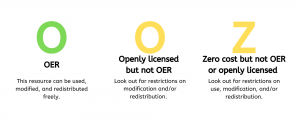| Developed by Marcus Dargan, Department of Communication Studies, Baruch College, CUNY |
This lesson plan was developed to provide students with the tools to produce critical feedback for introductory public speaking courses by sharing their observations on what they like, notice, and wonder about the visual, verbal, and vocal aspects of a speech. In addition to articulating critical feedback, like, notice, and wonder statements can be used as prompts for activating classroom dialogue, personal reflections, critical thinking, and conflict resolution.
The OER and Course Artifact
Lesson Plan
This lesson plan introduces students to the “like, notice, and wonder,” system of providing critical feedback through Liz Lerman’s Critical Response Process: a method for getting useful feedback on anything you make, from dance to dessert (Liz Lerman Dance Exchange, 2003). Lerman is a choreographer who developed this process as a means of communicating critique that is meaningful for both the artist and audience. It is an involved four-step process; however, this lesson only adapts the language of the first step as like, notice, and wonder statements.
I normally introduce this unit on critical feedback at the beginning of the semester in conjunction with the students’ first speech assignment. This allows for students to jump right in with producing constructive criticism of their classmates’ speeches with statements beginning with “I like…” I notice…” “I wonder…” Though these statements may seem simple at first, they provide students with immediate access to language that expresses their observations in a manner that is concise, inoffensive, and meaningful.
When I was first introduced to this system as a graduate student, it did not appeal to me. I felt it was too simplistic, restrictive, and passive-aggressive. You may find the same pushback from your students; however, I encourage you to stick with it. Over the course of the semester, students master their use of this system, and their statements quickly become more thoughtful and elaborate. (See the Video Analysis Essay.)
If you are interested in learning more about Liz Lerman’s work, you can visit her website or check out Critical Response Process at the Newman Library.
Aspects of public speaking
These lists are a compilation of student responses provided during the activation of this lesson plan. Students are instructed to use this resource to identify visual, verbal, and vocal aspects of public speaking they observe in completing their Video Analysis Essay. Students are also encouraged to use this resource in the early stages of providing critical feedback to their classmates.
video analysis essay
This assignment is used as an assessment of student comprehension of the aspects of public speaking and their ability to articulate them in giving critical feedback. Students will visit the TED website or YouTube channel to view any TED Talks video on a topic of their choice. They will submit an essay discussing the various aspects of public speaking observed in the video using “I like…” “I notice…” “I wonder…” statements.
Faculty Information
Marcus Dargan is an Adjunct Lecturer within the Communication Studies Department at Baruch College. He holds an M.S. Ed. In Educational Theatre and B.A. in Theatre from the City College of New York, and an A.S. in Theatre from Borough of Manhattan Community College.
Licensing Information
 Giving Critical Feedback is licensed under a Creative Commons Attribution Share-Alike 4.0 International license.
Giving Critical Feedback is licensed under a Creative Commons Attribution Share-Alike 4.0 International license.
 The Giving Critical Feedback materials created by Marcus Dargan are OER, but linked resources have other licensing conditions.
The Giving Critical Feedback materials created by Marcus Dargan are OER, but linked resources have other licensing conditions.

